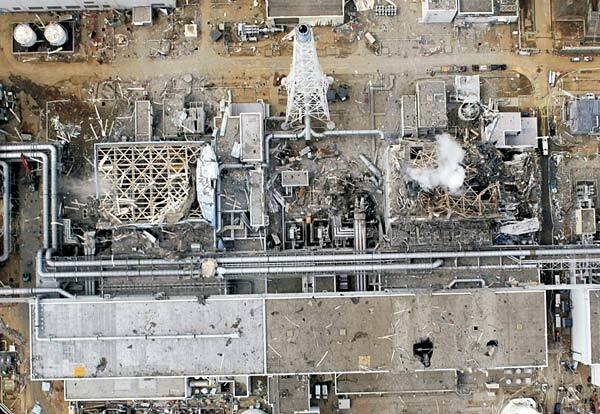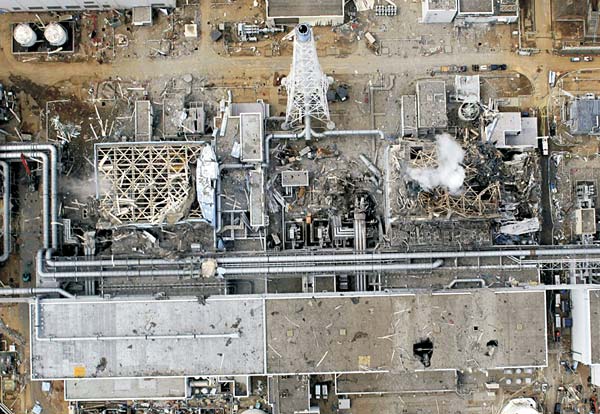Report urges more planning to cope with Fukushima-like event
DOI: 10.1063/PT.3.2510
The US nuclear industry and the Nuclear Regulatory Commission (NRC) should be more proactive about hazards that could affect the safety of nuclear plants, says a new report from the National Research Council.
The committee that wrote the report acknowledged the additional safety measures that were ordered by the NRC and are being implemented by the nuclear industry since the 2011 Fukushima nuclear accident (see Physics Today, May 2011, page 18

To avoid a Fukushima-like accident (the aftermath of which is shown in this 2011 photo), the US nuclear industry should seek out and act on newly available information about reactor safety hazards, says a National Research Council report.
AIR PHOTO SERVICE, JAPAN

The industry and the NRC should give specific attention to improving plant systems operation and training for catastrophic events, said committee member Robert Bari, senior physicist at Brookhaven National Laboratory. He added that procedural changes arising from that recommendation should be peer reviewed.
The committee, whose report was requested by Congress in 2012, urged the nuclear industry and emergency responders to assess their preparedness for large-scale nuclear accidents that could result from natural disasters. Emergency response plans, including communicating with affected populations, should be revised as necessary to ensure that they are scalable and effective. In addition, well-trained personnel and adequate resources for responding to long-duration accident scenarios need to be in place.
While acknowledging that the committee hadn’t the time or resources to perform an in-depth analysis of US preparedness for severe nuclear accidents, the report nonetheless expressed doubts that the country is prepared to cope with a disaster on the scale of Fukushima. “We also recommend that the nuclear industry and emergency responders assess the value of protective actions, such as sheltering in place, evacuation, relocation, and distribution of potassium iodide,” said committee member Barbara Hamrick, radiation safety officer at the University of California, Irvine Medical Center. “Particular attention should be given to protection for special populations—children, the elderly, and the ill; longer-term impacts of evacuation; shelter in place, including the social, psychological, and economic impacts; and decision making for resettlement in areas contaminated by radioactive materials.”
The committee was not asked whether the 10-mile emergency planning zone surrounding US reactors should be broadened. But its report said that planners should take into account actions needed in the event of a dispersion of radioactive materials outside that radius.
The report said particular attention should be given to improving the availability, reliability, redundancy, and diversity of such nuclear plant systems as DC power for instrumentation and safety-system control, tools for estimating real-time plant status during loss of power, and reactor heat removal. Other upgrade needs include hydrogen monitoring and mitigation, onsite and offsite radiation and security monitoring instruments, and instrumentation for monitoring pressure and temperature in reactors, containment, and spent-fuel pools.
The Nuclear Energy Institute, the industry’s trade association, said the core findings of the report “validate the actions that the U.S. industry has initiated in recent years and that the [NRC] is requiring to be ready to manage plants if extreme natural events occur that may exceed a plant’s design basis.” Anthony Pietrangelo, the institute’s senior vice president, said that in the three years since Fukushima, the industry has established an additional layer of backup emergency equipment at multiple sites for restoring power and reactor cooling-water flow, opened two national emergency response centers, and added backup sources of cooling water for spent-fuel pools.
Staff at NRC briefed commissioners on 31 July regarding post-Fukushima safety responses. “The NRC and licensees have taken real action, and those actions have resulted in significant safety improvements at the plants,” said Michael Johnson, the NRC’s deputy executive director for reactor and preparedness programs.
The nuclear industry, through the Institute of Nuclear Power Operations, has voluntarily established nuclear safety culture programs and mechanisms for evaluating those programs, noted committee member Emilie Roth, a nuclear consultant. The report said the NRC and the power industry must continuously monitor their safety culture. It cautioned that the NRC must maintain its independence and not allow “outside influences” to compromise that culture or hinder disclosures to the public about safety-related matters.
More about the Authors
David Kramer. dkramer@aip.org
